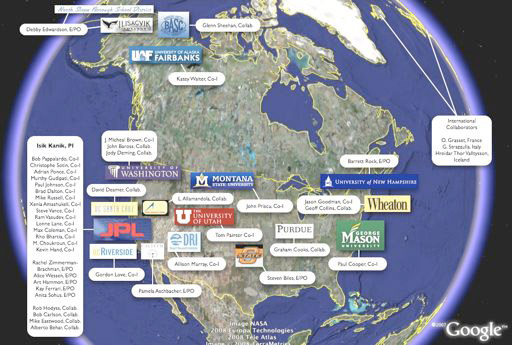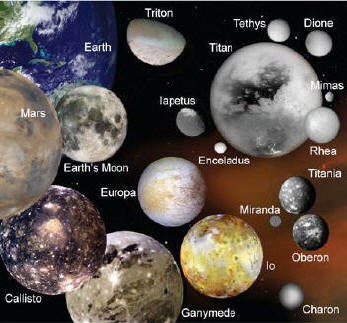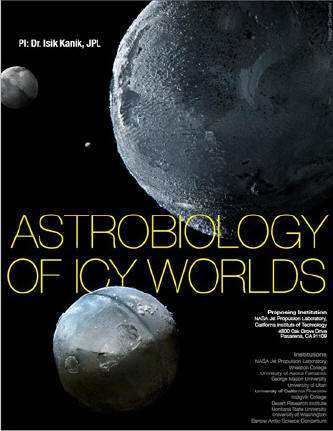Astrobiology of Icy Worlds: Habitability, Survivability, and Detectability
Rationale
Icy worlds such as Titan, Europa, Enceladus, and others may harbor the greatest volume of habitable space in the Solar System (Figure 1-1). For at least five of these worlds, Europa, Titan, Ganymede, Callisto, and Enceladus, considerable evidence exists to support the conclusion that oceans or seas may lie beneath the icy surfaces (Khurana et al. 1998, Kivelson et al. 2002, Collins and Goodman 2007, Lorenz et al. 2008). The total liquid water reservoir within these worlds may be some 30-40 times the volume of liquid water on Earth.
This vast quantity of liquid water raises two questions: Can life emerge and thrive in such cold, lightless oceans beneath many kilometers of ice? And if so, do the icy shells hold clues to life in the subsurface?
We will address these questions through three science investigations and one technology investigation. The science investigations are as follows:
- Investigate the Habitability of liquid water environments in icy worlds, with a focus on what processes may give
rise to life, what processes may sustain life, and what processes may deliver that
life to the surface.
- Investigate the Survivability of biological compounds under simulated icy world surface conditions, and compare
the degradation products to abiotically synthesized compounds resulting from the radiation
chemistry on icy worlds.
- Investigate the Detectability of life and biological materials on the surface of icy worlds, with a focus on spectroscopic
techniques, and on spectral bands that are not in some way connected to photosynthesis.
Ultimately, the presence of life on icy worlds is of little scientific utility if robotic and human explorers cannot discover the inhabitants. The search for life requires instruments and techniques that can detect biosignatures in space. Advancing this capacity is the focus of our Technology Investigation: - Develop a Path to Flight for astrobiology instrumentation built with non-NAI funding (e.g., the Astrobiology Science and Technology Instrument Development, and Astrobiology Science and Technology Experiment Programs) that has not yet reached a technology readiness level adequate for flight.
Research on the methane rich lakes near Barrow, AK is addressing investigations 1 through 3.
The synthesis of our investigations emerges from the fact that each investigation is predicated on the one before it. If we are to discover life on another world, then there must be some detectable signature of that life. In order for a detectable biosignature to persist, something of, or from, the original organism must have survived in the surface ice. For that to occur, various processes beneath the surface must have provided for habitable conditions and a means to transport the organism to the surface.

Map of 'Astrobiology of Icy Worlds' Co-Investigators and Collaborators.
Ice as a Unifying Theme
Ice is the dominant phase of water in the solar system, and to follow the water, is to follow the ice. Our highly interdisciplinary team of researchers will be working from the scale of microbes in ice to that of convection in ice shells to better understand and constrain the many ways in which icy worlds may provide habitable niches.
As part of our effort, we will investigate - in the laboratory, analytically and numerically, and in the field - the properties and chemistry of ice. In so doing we aim to advance our understanding of the role of ice in the broad context of astrobiology. Our work applies to icy regions on Earth and extends to worlds well beyond Pluto.
Education and Public Outreach
Our E/PO program focuses on innovative methods, tangible materials, and engaging research activities for students and community members alike. As part of our program we will teach students how to do spectroscopy with a compact disk, we will produce "Icy World Trading Cards," and we will have students working with real satellite data to do spectroscopic measurements on the health of our Nation's forests. Our "Rainbows of Life" initiative seeks to make the science of light spectroscopy (a fancy term for looking at rainbows) fun and easy for students and adults.
Finally, for our fieldwork campaign in Alaska we have teamed with Ilisagvik College, Alaska's only Tribal College, and we will be engaging the local Inupiat students in hands-on research pertaining to both terrestrial climate change and astrobiology.


